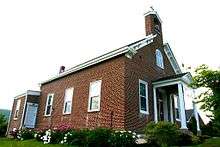Brownsville, Maryland
| Brownsville, Maryland | |
|---|---|
| census-designated place | |
 Location of Brownsville in Maryland | |
| Coordinates: 39°22′55″N 77°39′37″W / 39.38194°N 77.66028°W | |
| Country | United States |
| State | Maryland |
| County | Washington |
| Elevation[1] | 545 ft (166 m) |
| Time zone | Eastern (EST) (UTC-5) |
| • Summer (DST) | EDT (UTC-4) |
| ZIP code | 21715 |
| Area code(s) | 301 |
| FIPS code | 24-24043 |
| GNIS feature ID | 589837[1] |
| Other name | Banjotown[1] |
| [2] | |
Brownsville is a small unincorporated community and census-designated place in Washington County, Maryland, United States, near Gapland in an area known as Pleasant Valley.
Geography
Brownsville is located at 39°22′55″N 77°39′37″W / 39.38194°N 77.66028°WCoordinates: 39°22′55″N 77°39′37″W / 39.38194°N 77.66028°W (39.382045, -77.660269), at an altitude of 545 feet (166 m) above sea level.[1]
History
Tobias Brown, son of Rudolph Brown, was one of the first settlers of Washington County, and owned a tract of farmland extending from Gapland, south to the future location of Brownsville.[3] John Brown, son of Tobias, and his son Cornelius established a tannery in the swamp land at the head of a small tributary to Israel Creek, and built a home on the east side of the valley overlooking the tannery. The town was named for the family. The first post office in Brownsville was established January 28, 1833, with John H. Beall as postmaster.[4] He was succeeded on February 3, 1836, by John Brown, who was born near Brownsville, December 20, 1790, served as a soldier in the War of 1812 and saw action at the Battle of North Point. After the war, in 1824, he built the first homestead in what is now Brownsville, of timbers pre-cut in Hagerstown, and brought to the site by wagon, using hand-made bricks to fill in between the timber framing, and covered by weatherboard cut by hand from South Mountain trees.[5][6] John Brown served as postmaster until 1863, when he was succeeded by his son, Cornelius, who (with a break in 1886–89) served until February 1894.[7] Cornelius's son, George T. Brown, was appointed to the post in February 1898 and held it for over 40 years.[7]

Two churches were founded in Brownsville. The Church of the Brethren was founded by Rudolph Brown in the years following the close of the Revolutionary War. A meetinghouse was erected in the village in 1852 and served the congregation until the building of their present church along MD 67 in 1960. Two additional congregations were founded from the Brownsville Church: West Brownsville at Yarrowsburg (1907-1960) and South Brownsville at Garretts Mill (1914-1960). Both of these congregations were re-joined to the Brownsville Church in 1960. St. Lukes Episcopal Church was organized August 21, 1837 as a chapel within St. Mark's Parish. The brick church was erected in 1839 and continues to serve the congregation today. During the Civil War, the church was used as a field hospital following the Battle of Antietam. Afterwards, it was burned by the Union Army to prevent Confederates from using the structure given its proximity to the border line at the Potomac River. The church was restored in 1869.[8]
References
- 1 2 3 4 U.S. Geological Survey Geographic Names Information System: Brownsville, Maryland
- ↑ "ZIP Code Lookup". Retrieved 2008-12-26.
- ↑ Kenny, Hamill. (1984). The Placenames of Maryland, Their Origin and Meaning, p. 48. Baltimore, Md: Museum and Library of Maryland History, Maryland Historical Society. ISBN 0-938420-29-1.
- ↑ Smith, Chester M., Jr., and Kay, John L. (1984). The Postal History of Maryland, The Delmarva Peninsula, And The District of Columbia: The Post Offices and First Postmasters from 1775 to 1984, p. 198. Burtonsville, Md: The Depot. Library of Congress Card No. 84-72653.
- ↑ Forster, R. K. "Postmarks, Places & People", in Stamp Magazine, published in the UK, September 1974, p. 65.
- ↑ The Postmaster's Advocate, November 1939. A memorial stone in the town's Brethren Church cemetery records that John Brown died August 10, 1888, at the age of 97 years, 7 months, 20 days.
- 1 2 U.S. National Postal Archives. Cornelius is listed in the 1880 United States Census as a farmer and tanner.
- ↑ St. Lukes Episcopal Church. "History".

